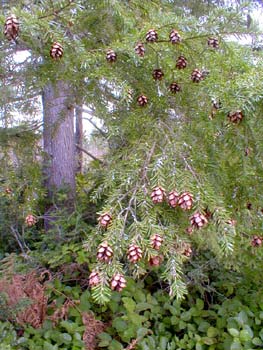
Western Hemlock
"Under the greenwood tree
Who loves to lie with me,
And tune his merry note
Unto the sweet bird's throat."
-William Shakespeare
The genus name of Tsuga heteraphylla is from the Japanese, & means "Mother Tree." The Mother Tree is one of the most majestic in the Pacific Northwest, second only to the Douglas-fir. It is the State Tree of Washington, & is found on the Kenai Peninsula of Alaska, in British Columbia, Washington, Oregon, northwestern California, & inland in high rainfall regions of southeastern British Columbia, northern Idaho & northwestern Montana. It likes best the coastal regions where rainfall is plentiful.
It is easily spotted even at a distance, having a unique pose: It is a narrow tree with drooping branches, with its top leaning over, like a woman with her head bowed in prayer.
Pioneers named it "hemlock" because they thought the bruised needles smelled like the poisonous European weed with which Socrates committed suicide. It is most commonly called Western Hemlock, Pacific Hemlock, or West Coast Hemlock.
But it has a plethora of secondary common names including Hemlock Fir, Alpine Hemlock, Berg Hemlock, Weeping Spruce, Black Hemlock, Mountain Hemlock, Hemlock Spruce, Alaska Pine, or Grey Fir. It's been known as Patton's Hemlock, after Alaska coastal surveyor Raymond Stanton Patton (1882-1937); Williamson's Spruce, after botanist Herbert Bennett Williamson (1860 -1931); & Prince Albert Fir, in honor of the consort of Queen Victoria, for Prince Albert of Saxe-Coburg (1819-1861) had a great interest in the natural sciences.
Though often seen in mixed forests of Douglas fir, western red cedar, & grand fir, it is just as commonly seen as the dominant tree or even in pure stands. Because it can tolerate more shade than most large trees, it can colonize the substory of a Douglas fir forest & over a period of centuries displace the firs.
They have shallow root systems & are prone to blow-down, & can be brittle at sea level, commonly showing long vertical cracks in the trunk. There are many young, middle-aged, & old hemlocks on & around a friend's property in sight of Hood Canal. Some of these, alas, will eventually have to be removed, as they could easily crush buildings if blown down, & they do show the vertical cracks typical of hemlocks at sea level.
An arborist dropped by to look at these trees & assess their safety. He said the cracks were the result of these trees being struck by other trees when timberman removed Douglas firs many years earlier, before the area was developed for housing. But I don't believe that's the case; the cracks are just a commonplace for hemlocks at sea level.
The cones are numerous & relatively small, dangling at the tips of young branches. The photo above shows a branch of late-winter cones with seeds recently dispersed.
An important lumber tree, it is locally secondary only to the Douglas fir. It's noted for rapid growth, & produces more lumber per acre than any other tree. It is ideal for narrower lumber, window frames, doors, plywood, railroad ties, broom handles, ladders, interior & exterior joinery, pallets, furniture, paneling & veneer.
The wood has a fine grain that polishes & stains well. The wood is fairly hard & resistant to scratching, so liked for flooring, staircases, & railings. The trees are a major source of pulp in paper manufacture.
It has sufficient commercial uses that it been introduced into Europe as a plantation tree. It was first planted in England in 1851 by the inveterate plant explorer David Douglas.
Native peoples scraped the inner bark to prepare as edible cakes, or mixed with bear grease & whipped into fresh snow for an ice-cream type of desert. The bark is high in tannins & was used by Salish tribes for tanning hides, in the process dying the hides red. The red dye of the hemlock was also used to color baskets & goat wool. The Saanich even used the dye as a facial rouge.
Hunters would rub their bodies with needles so that deer would smell only the natural oils & might not detect human presence. This was sometimes thought also to protect from dismal spirits of the woods.
Needles & young branch tips were used to brew herbal teas. The sap was used as chewing gum & for sundry medicinal purposes.
The life span of the tree is usually less than a century, especially at sea level, but 500 to 800 year old hemlocks are known, mainly at higher elevations. With many adult trees reaching 100 to 150 feet, it is the tallest species in its genus. A record giant was measured at 259 feet. The oldest trees can be eight feet in diameter.